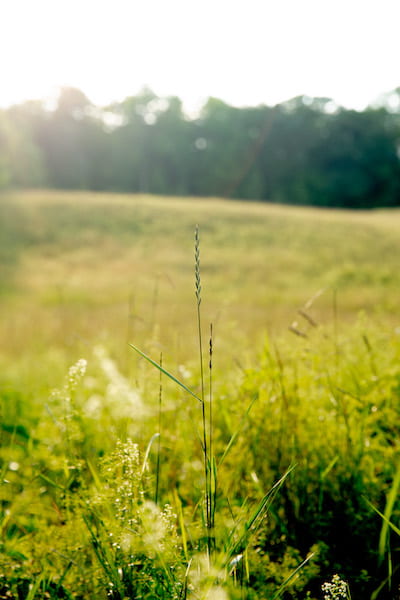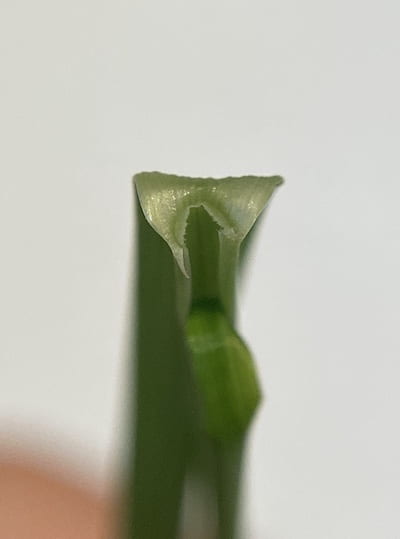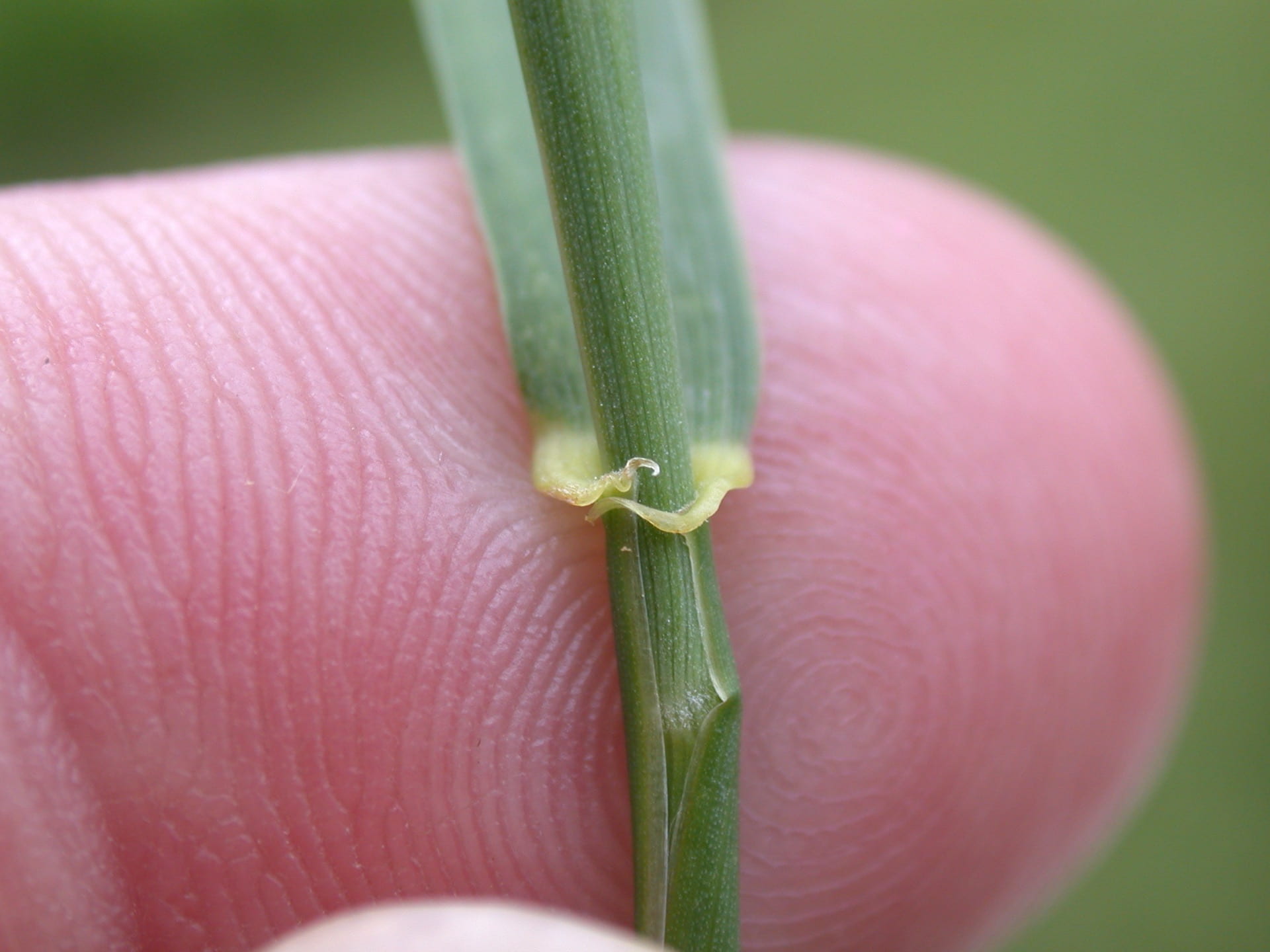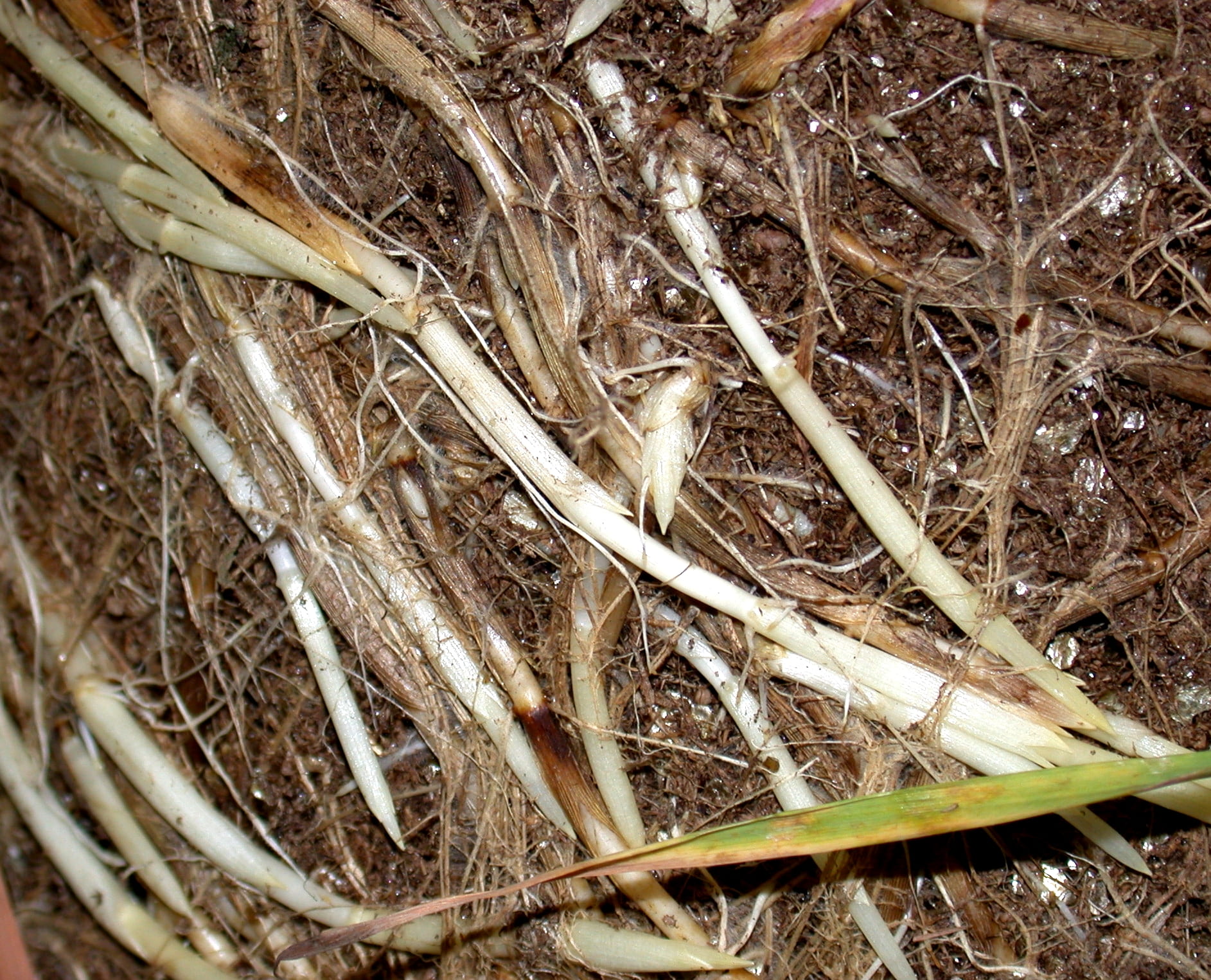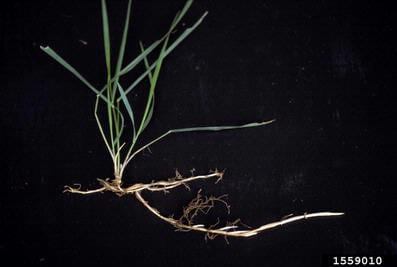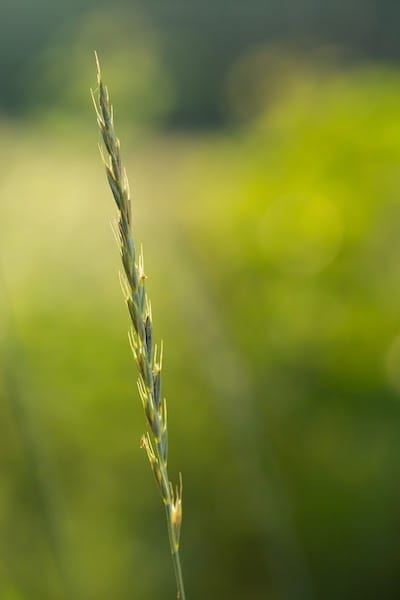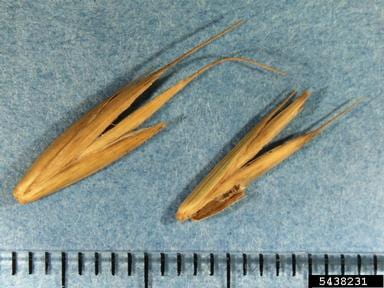Scientific names: Elytrigia repens, previously Agropyon repens
Other names: quitch grass, couch grass, wheat-grass, shelly-grass, knot-grass, devils-grass, scutch-grass, quick grass
Quackgrass (Elytrigia repens) is a perennial that originated in Europe, northern Africa, and temperate Asia and India. It came to the U.S. via contaminated hay/straw, and is moderately drought resistant. It is a problem for NYS in small fruit (berries), field crops, and vegetable systems. It can also be problematic when growing potatoes as the upcoming rhizomes are sharp and can pierce potato tubers, which lowers tuber quality. It can grow in a wide range of soil pH and textures, but thrives in heavier, more basic pH soils.
Identification
Seedlings: The leaf bud is rolled. Quackgrass has distinctive auricles, but they are often undeveloped on seedling leaves.
Seedling leaf size: 3.5-8 in (9-20 cm) long by 0.08-0.1 in (0.2-0.25 cm) wide
Seedling ligule size: >0.02 in (0.05 cm) long
Mature plant: The auricle’s shape is long and clasping. The upper sheaths are smooth, with hairs towards the base of the plant. The root system produces extensive, sharply pointed rhizomes.
Height: 4 ft (1.2 m)
Ligule length: 0.04 in (0.1 cm)
Rhizome spread max: 24 in (60 cm) wide by 8 in (20 cm) depth.
Spikelet of quackgrass.
Photo by Julia Scher of Federal Noxious Weeds Disseminules, USDA APHIS PPQ, via Bugwood.org
Similar species
Table 9: Shows quackgrass (Elytrigia repens) similarities and differences in identification compared to its similar species: tall fescue (Schedonorus arundinaceus) and ryegrasses (Lolium multiflorum and Lolium perenne species).
| Species | Quackgrass (Elytrigia repens) | Tall fescue (Schedonorus arundinaceus) | Ryegrasses (Lolium multiflorum, L. perenne,etc.) | ||
|---|---|---|---|---|---|
| Similarities | Leaf bud rolled; ligule membranous | Leaf bud rolled; ligule membranous | Ligule membranous | ||
| Differences | Auricle long and clasping (often not present on seedlings); long, pointed, rhizome | Auricle blunt and lobe-like, can be absent; lack lengthened rhizomes; grows in a clump | Leaf bud folded; auricle of L. multiflorum variable (clasping to blunt); auricle of L. perenne if present is short or malformed; lack lengthened rhizomes; grows in a clump |
Management
Chemical
See Cornell’s Turfgrass and Landscape Weed ID for more information on chemical control.
You can also use CCE Eastern NY Horticulture’s herbicide lookup tool to find the efficacy of various herbicides on quackgrass. For general guidance on weed control, get the latest edition of the Cornell Crop and Pest Management Guidelines.
Non-chemical
There can be an increase of quackgrass when crop rotation consists of spring cereal grain and legume forage crops. In cases of severe infestations, extensive tillage is required to control quackgrass. Prevention of an infestation is key to protect soil health, as tillage reduces soil organic matter and may increase erosion risk. When tillage cannot be avoided, integrating cover crops should help combat these issues.
The quickest method for control of very heavy infestations is to dry out rhizomes. This can be done by plowing the soil when wet so that the soil becomes cloddy, then stir repeatedly over a long fallow in dry weather. Another option is a deep chisel plow followed by repeated passes over several days with a spring-toothed harrow to pull out rhizomes.
The main control tactic in moderate populations is to diminish rhizome storage reserves; however, because tillage negatively affects soil health control should take place before quackgrass becomes a problem. Control is most effective when the shoot has three leaves as this is when the rhizome reserves are low, but management practices are still suitable whenever the shoot is apparent. Although quackgrass is not harmful to grazers and is nutritious, it can quickly overtake other more beneficial forage crops and therefore should be controlled.
Natural enemies:
Agropyron, a mosaic virus, has little impact on grass growth. Grazers (cattle, sheep, horses) keep this weed in check. Pigs are also a valuable method of control as they will dig out and consume the rhizomes.
Climate Change and Management
Quackgrass grown under elevated CO2 concentrations has shown a higher resistance to glyphosate. Higher CO2 concentrations increase the waxy cuticle layer of many grasses, including quackgrass, and may explain this increased glyphosate resistance. As CO2 concentrations rise with climate change quackgrass is likely to become more challenging to manage with glyphosate.
# of studies referenced in this section: 2
Herbicide resistance
Reported as of 2021:
None
Visit the International Herbicide-Resistant Weed Database homepage for more information on resistance.
References
For extensive information on how to control quackgrass in an organic system check out this factsheet from Maine.gov.
The University of Vermont Extension has information on quackgrass management in vegetable and berry crops.
The University of Maryland Extension also has biological and management tactics on their quackgrass page.
Quackgrass has proven to be problematic when growing potatoes as discussed above. Check out the UC IPM Special Weed Problems page which describes why this is the case for Northern California potato growths.
Non-chemical management is largely from the upcoming book, Manage Weeds on Your Farm: A Guide to Ecological Strategies by Charles L. Mohler, John Teasdale, and Antonio DiTommaso (Publisher: SARE Outreach, expected late fall of 2021).
Uva R H, Neal J C, DiTomaso J M. 1997. Weeds of the Northeast. Book published by Cornell University, Ithaca NY. The go-to for weed ID in the Northeast; look for a new edition sometime in 2019.
Hager, H.A. et al. (2016) ‘Effects of elevated CO2 on photosynthetic traits of native and invasive C3 and C4 grasses’, BMC Ecology, 16(1). doi:10.1186/s12898-016-0082-z.
Fernando, N. et al. (2016a) Glyphosate resistance of C3 and C4 Weeds under rising atmospheric CO2, Frontiers in plant science.

